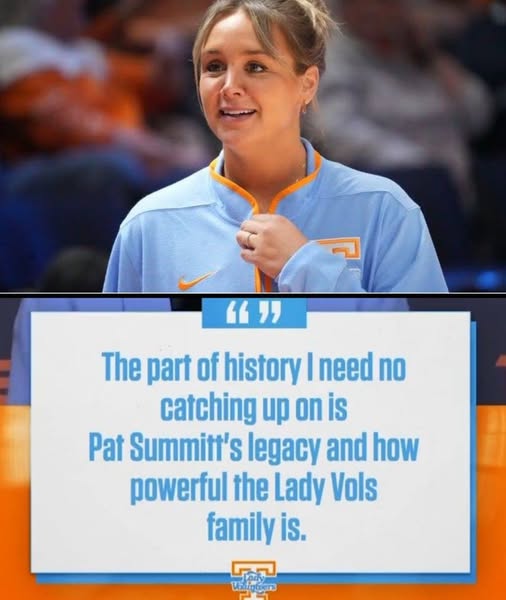The Sweetheart of Success: Pat Summitt’s Golden Legacy in Women’s Basketball and Beyond”
In the ever-evolving world of sports, few names echo through the annals of history with the resonance of Pat Summitt. Revered, remembered, and rightfully immortalized, Summitt wasn’t just a coach—she was a standard bearer, a game-changer, and a beacon of grace who transcended basketball. Her accolades are as awe-inspiring as they are countless: eight NCAA championships, 1,098 career wins, and the most NCAA Division I wins by any basketball coach—man or woman—at the time of her retirement. But her impact wasn’t confined to the hardwood. Pat Summitt left behind a legacy that threads through the hearts of those she coached, inspired, and mentored. She was—and remains—the Sweetheart of Success, whose influence defined excellence and integrity in women’s sports.
Born for Greatness
Born Patricia Sue Head on June 14, 1952, in Clarksville, Tennessee, Pat Summitt was raised on hard work, faith, and grit. The daughter of a dairy farmer, she learned the value of discipline early, rising at dawn to help with chores before heading off to school. Her upbringing taught her that nothing comes without effort, and this foundation would become the cornerstone of her coaching philosophy.
Pat’s love for basketball developed quickly. When her family moved so she could attend Cheatham County High School, which had a girls’ basketball team, it was a sign of the importance her family placed on her athletic potential. After excelling in high school, she went on to play at the University of Tennessee at Martin, where she was an All-American. A competitor to the core, she was also a member of the 1976 U.S. Olympic Team, earning a silver medal—the first Olympic medal ever awarded in women’s basketball.
A Titan Takes the Sidelines
In 1974, at just 22 years old, Pat Summitt was named head coach of the University of Tennessee Lady Vols. She inherited a team without scholarships, without resources, and without national recognition. Yet within a few short years, she turned Tennessee into a powerhouse. Under her leadership, the Lady Vols not only competed with the best but became the best.
What made Summitt different wasn’t just her strategy or her fiery intensity—it was her ability to demand excellence while nurturing growth. She treated her players as student-athletes first, ensuring they graduated, stayed disciplined, and matured into strong, independent women. She demanded toughness but offered boundless support. She could be brutally honest but was always loyal. It was this balance that made her such a phenomenal leader.
The Championships and the Chase for Perfection
Pat Summitt’s Lady Vols became synonymous with winning. From 1987 to 2008, she guided Tennessee to eight NCAA championships—1987, 1989, 1991, 1996, 1997, 1998, 2007, and 2008. Her run in the late 1990s, particularly the 1997–98 season, was historic. That squad went 39-0, led by the transcendent Chamique Holdsclaw, widely considered one of the best teams in NCAA women’s basketball history.
Summitt didn’t just build winning teams; she built dynasties. She had 22 Final Four appearances, coached 161 NCAA tournament games, and guided Tennessee to 16 SEC regular-season titles and 16 SEC tournament titles. But she never let the trophies define her.
“It’s not about the wins and losses. It’s about the impact you have on young women and helping them grow into leaders.” That quote encapsulated her approach. She was shaping people, not just players.
A Mentor to Legends
Under her tutelage, a who’s who of women’s basketball flourished. Names like Tamika Catchings, Chamique Holdsclaw, Candace Parker, Michelle Marciniak, and Semeka Randall became not only stars at Tennessee but also legends in the WNBA and on the international stage. Many of her former players became coaches, broadcasters, and advocates for women’s sports—evidence of the ripple effect she created.
Tamika Catchings once said, “Coach Summitt taught us how to win on the court and in life. Her strength, poise, and leadership continue to guide me every day.” Candace Parker echoed similar sentiments, noting how Summitt never allowed her to settle for anything less than her full potential.
The Gold Standard in Every Way
Pat Summitt’s legacy can be summed up by one word: standards. She set them high—for her players, for her staff, and for herself. And she never wavered. Her practices were demanding, her game plans meticulous, and her standards for academics uncompromising. Every Lady Vol under her watch knew what it meant to earn the jersey and represent Tennessee.
Her coaching record, culminating in an astounding 1,098 wins, is a testament to her durability, vision, and consistency. More impressively, every player who completed eligibility under her graduated. That’s not just rare—it’s nearly unheard of.
In 2000, she became the first female coach to receive the Naismith Coach of the Century Award. She was also inducted into the Naismith Memorial Basketball Hall of Fame and the Women’s Basketball Hall of Fame—where she fittingly belonged before the ink had dried on her career resume.
The Final Battle: Courage in the Face of Alzheimer’s
In 2011, at the age of 59, Pat Summitt revealed she had been diagnosed with early-onset Alzheimer’s disease. The basketball world, and the world at large, were stunned. Yet, true to her nature, Summitt confronted the disease with bravery, candor, and defiance.
She continued to coach for one more season, leading the Lady Vols to the Elite Eight in 2012 before stepping down. She transitioned to a Head Coach Emeritus role and devoted herself to raising awareness and funding for Alzheimer’s research. The Pat Summitt Foundation was born out of this mission—a lasting legacy in the fight against a cruel disease.
Her public battle with Alzheimer’s helped destigmatize the disease and gave it a face—one full of grit and grace. “I can’t control what’s happening, but I can control how I respond,” she once said, and respond she did—with dignity and fire.
A Legacy That Lives On
Pat Summitt passed away on June 28, 2016, at the age of 64, but her legacy continues to blaze. The Pat Summitt Leadership Group, the Pat Summitt Alzheimer’s Clinic at the University of Tennessee Medical Center, and the Summitt Circle—the ring surrounding the court named in her honor—are all testaments to her enduring impact.
Her statue stands outside Thompson-Boling Arena in Knoxville, arms folded, eyes forward, as if eternally watching over the next generation of Lady Vols. Inside the arena, her presence still reverberates in the banners, in the paint of the court bearing her name, and in the hearts of every player who slips on a Tennessee jersey.
She wasn’t just a coach. She was a movement. She was the mentor, the motivator, the mother figure, and the master strategist. She taught America that women’s basketball wasn’t just worth watching—it was worth celebrating.
The Pat Summitt Effect
Even now, nearly a decade after her passing, Summitt’s influence is everywhere. It’s in the coaching philosophies of rising stars like Dawn Staley, who often cites Summitt as an inspiration. It’s in the grit of every women’s team pushing past adversity. It’s in the voices of sportscasters calling women’s games with pride. And it’s in the growing attendance, respect, and revenue that women’s basketball now enjoys.
The recent rise in popularity of stars like Caitlin Clark, Angel Reese, and Paige Bueckers owes a debt to the path carved by Summitt. The WNBA’s expanding visibility? Summitt helped lay that groundwork. The coaching landscape in women’s college basketball, increasingly diverse and competitive? That’s Summitt’s influence, too.
Beyond Basketball: The Gold Standard in Life
Pat Summitt’s excellence was not limited to her profession—it flowed into every facet of her life. She was a mother to her son, Tyler, a fierce advocate for education, and a pillar of strength for countless women. She reminded everyone that leadership wasn’t about titles—it was about service, and it was about the daily, intentional pursuit of doing things the right way.
Her values were simple but profound: accountability, honesty, loyalty, respect, and discipline. These were the bricks with which she built her program and her life.



